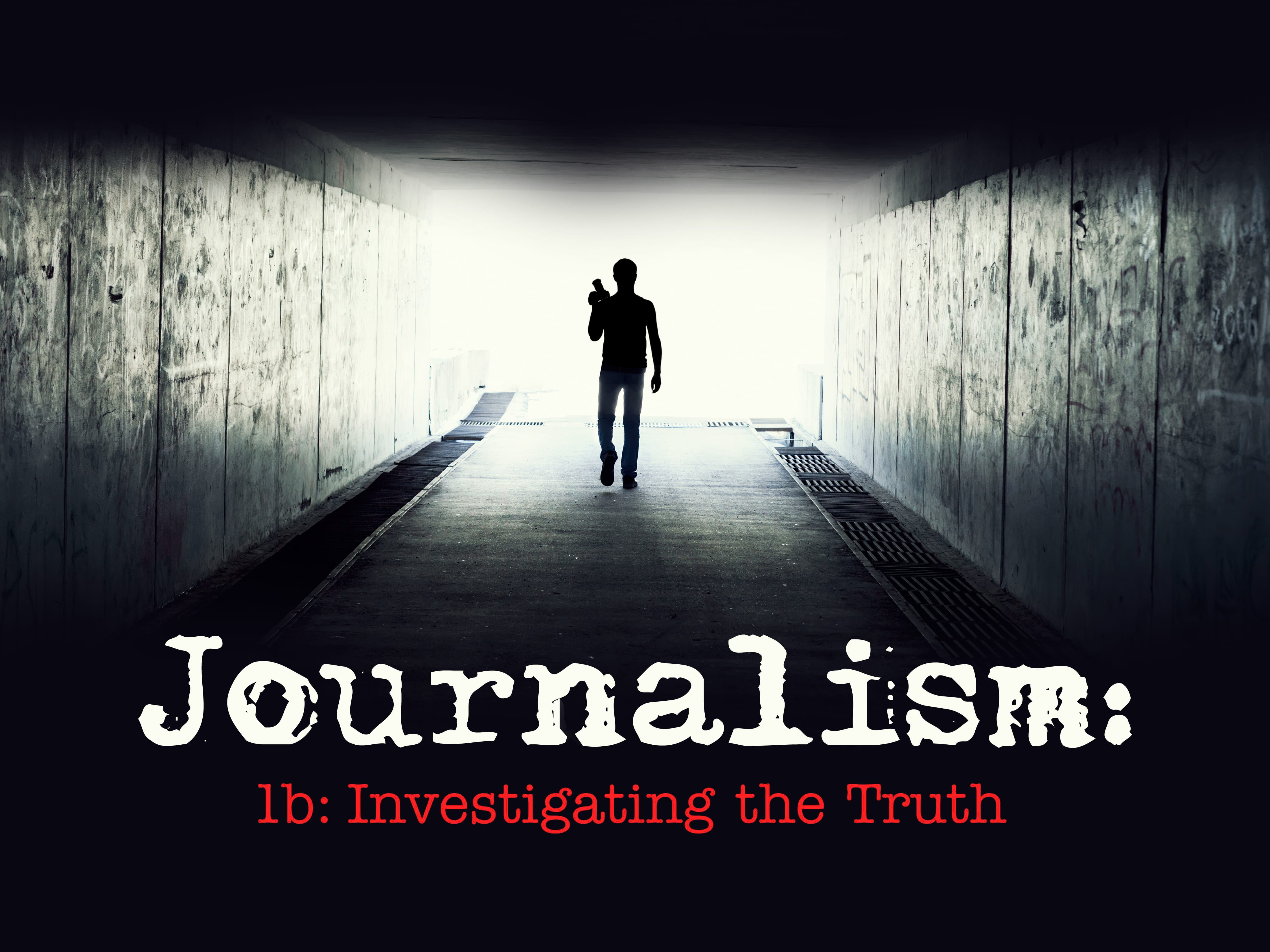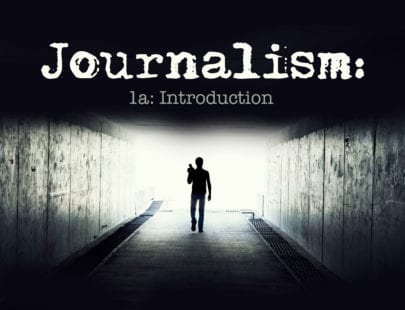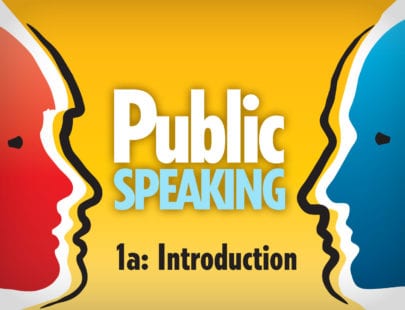
Journalism 1b: Investigating the Truth
Journalists are asked to tell the world a story every single day—and their job is, to tell the truth. Learn how to choose a topic, structure your story, research facts, hone your observational skills, and write an article following journalism tradition. Go beyond the print world and discover how journalism can lead to exciting careers that will put you right in the action.
Units at a Glance
Unit 1: How to Write Stellar News Stories
When you pick up a newspaper or read online about the latest game, community event, or international crisis, you expect to find certain things in each story. You may not even recognize what those qualities are, but you know something is wrong if they are not there. News stories follow a similar pattern and, depending on their topic and focus, even a similar structure. In this unit, you’ll learn about the different types of news stories and how you can create your own. You’ll learn how to choose a topic, structure your story, and develop and write it following the journalism tradition—and get a chance to practice those skills in your own article!
What will you learn in this unit?
- Understand the different types of stories that make up journalistic writing
- Identify the elements of news stories and replicate them
- Structure a news story based on the journalistic outline
- Plan and write a news story that fits the criteria for one of the types discussed in the unit
Unit 2: Researching Your Story Wisely and Well
Journalists are asked to tell the world a story every single day—and their job is to tell the truth. The best way to make sure that you’re telling the right story is to make sure that you have the right information. Researching sounds like such a boring task, but the truth is that you research all the time. Any time you ask Siri for the answer to a question or Google to find the directions to a new restaurant, you use research skills. In this unit, you’ll learn how to approach research in a digital world, the best strategies to get the best information for your story, and how to decide if the source you’ve found is the best one.
What will you learn in this unit?
- Understand the role of research in journalism.
- Identify the difference between fact checking and knowledge-based journalism.
- Distinguish between a primary and secondary source and a credible and not credible source.
- Create a strategy for finding the information you need.
- Use key words and search engines/databases to find information.
Unit 3: Using Personal and Observational Sources
Journalism is all about using your senses and being on the scene. No one really believes that a story can be truly told from behind a computer screen. You can’t capture the color and life of a story unless you’re there—and that’s the reporter’s unique challenge. Reporters doing their job are on the ground, pencil or wireless recorder or cell phone in hand, recording what they see so that they can bring it back to their readers. In this unit, we’ll talk about the types of sources that form the bulk of every reporter’s information arsenal: observational and personal sources. You’ll learn how to gather and use this information most effectively, as well as what can happen when these sources are not used as well as they could be.
What will you learn in this unit?
- Identify the differences between observational and personal sources.
- Understand how to find and cultivate good-quality sources.
- Create effective interview questions and conduct interviews well.
- Use source material to create compelling stories.
Unit 4: Preparing Posts for Publication
Every reporter and journalist produces stories that have to get the approval of one person: the news editor. Whether that editor oversees a newspaper section or a magazine as a whole or is responsible for supervising a broadcast newscast, the process of getting a story approved by an editor is the final hurdle for any journalist. Editors and producers look for not only interesting stories that contain good information but also error-free writing. Editors are, for lack of a better analogy, the “teachers” of the journalism world. They check work, suggest changes, demand revisions, and give approval when a final product meets their criteria. In this unit, we’ll talk about how you can take the skills you’ve already learned throughout your school years about the writing process and apply them to your writing as a journalist, as well as how to understand what an editor may be asking you to change. The revising process is the final part of a writer’s day—and perhaps the most important—so that’s what we’ll talk about here.
What will you learn in this unit?
- Understand the writing process and how it relates to journalism and writing under a deadline.
- Work step by step through a piece of writing to revise for content and edit for clarity and concision.
- Explore the role of an editor.
- Learn the meaning of proofreader marks used for noting grammatical errors and style.
- Identify and revise common grammatical and writing errors.
- Use attribution successfully in writing and understand the purpose behind it.
Unit 5: Understanding the Publication Process
If you could be a fly on the wall of a newsroom, either broadcast or daily newspaper, on any random day, you might be surprised at how similar the process of creating the news really is. From the morning meeting to assign stories to the pressure-filled race to go to press or on the air, reporters and editors and photojournalists are in a mad scramble not only to get the story right but also to get the story in on time. In this unit, you’ll learn about the process of publication from the flow of a day to the layout of a news broadcast or newspaper. You’ll learn the steps you need to create your own newspaper or news broadcast. Then you’ll take the work you’ve been doing throughout the course and do just that!
What will you learn in this unit?
- Understand the steps of creating the content of a newspaper or news broadcast.
- Identify the parts of a news broadcast—including packages, teases, art, and segments—and learn how to create them.
- Identify the four parts of a newspaper layout—headlines, text, art, and captions/cutlines—and tips to create them well.
- Apply this knowledge to create your own miniature version of a news broadcast or newspaper.
Unit 6: The Changing Environment of Journalism
Extra! Extra! Read all about it! No doubt you’ve watched at least one old movie or TV show where a newspaper seller was shouting these words on a street corner with a pile or papers in their arms. People used to have to wait for their daily paper—or when something really exciting happened, an extra edition—to find out about local, national, and world events. The speed of the mail, telegraph, and eventually telephone is what dictated what news was available to share that day. In this unit, we will look at how and why technology—mainly the internet—has changed the way news is delivered and how that affects the consumption habits of different age groups. Plus, we’ll take a guess at how this evolution will continue to change the future of journalism.
What will you learn in this unit?
- Discuss how technology is changing the scope of journalism
- Explore how consumer habits are changing journalism
- Understand the change in demographics of those consuming news stories
- Analyze the impact that technology, consumer habits, and demographics have on the future of journalism
Unit 7: Data and Journalism
Big data. Virtual reality. Artificial intelligence. Journalism has come a long way since a cub reporter with a typewriter handed off their copy to the newspaper editor to get a story in the evening edition of the paper. Sure, reporters on the ground digging up stories and talking to sources will always be the lifeblood of journalism. But the future is here. Changing consumer habits, advances in technology, and the emergence of big data—enormous sets of data that can be analyzed and mined for information and trends—all have led to a sea-change in journalism. In this unit, we’ll look at the new ways journalists are identifying, building, and presenting news stories with the use of data journalism and how artificial intelligence is helping that process happen without human intervention.
What will you learn in this unit?
- Explain what data journalism is and why it is important
- Discuss how a data journalist uses data to tell a story
- Understand the use of artificial intelligence (AI) in journalism
- Describe the ethical implications of AI in journalism
Unit 8: Careers in Journalism
Journalists today have many options beyond the newsroom. With strong writing, research, and content creation skills, you have many options for a varied career. From working in the corporate world to freelancing to hosting your own podcast. In this unit, we’ll learn about the education and experience needed to become a journalist and how and where to get hired. Plus, we’ll look at a few specialized niches in journalism that may help guide your career direction.
What will you learn in this unit?
- Identify the education and work experience needed to become a journalist
- Discuss how to create a writing portfolio
- Explore types of employers that hire journalists and the jobs they provide
- Discover opportunities in journalistic niches
Required Materials
Software
- Word processing software



